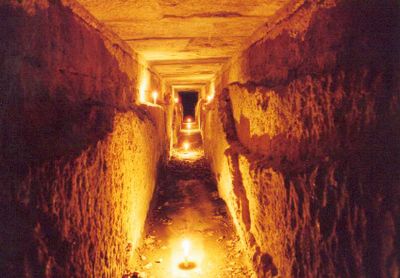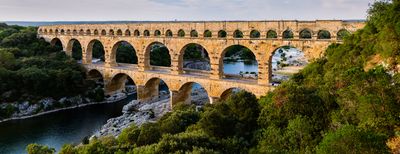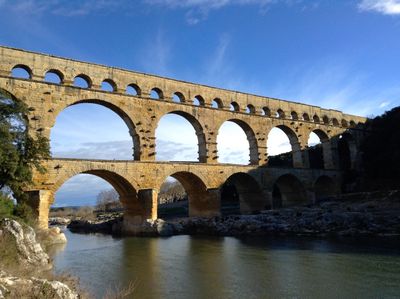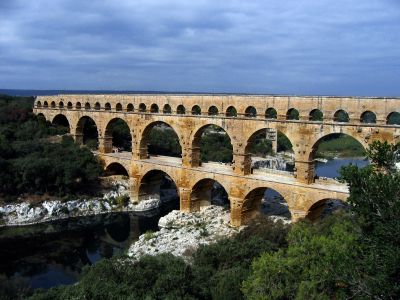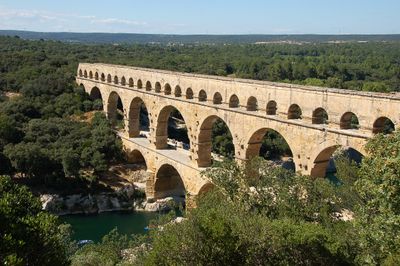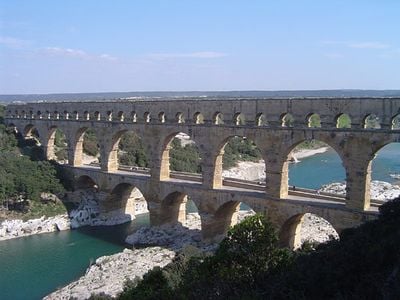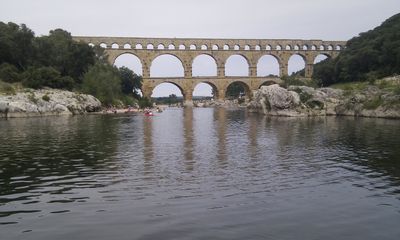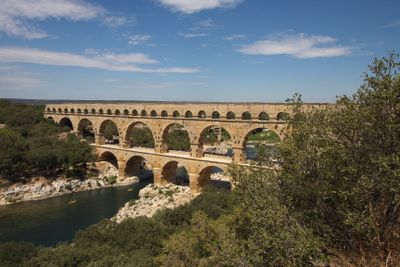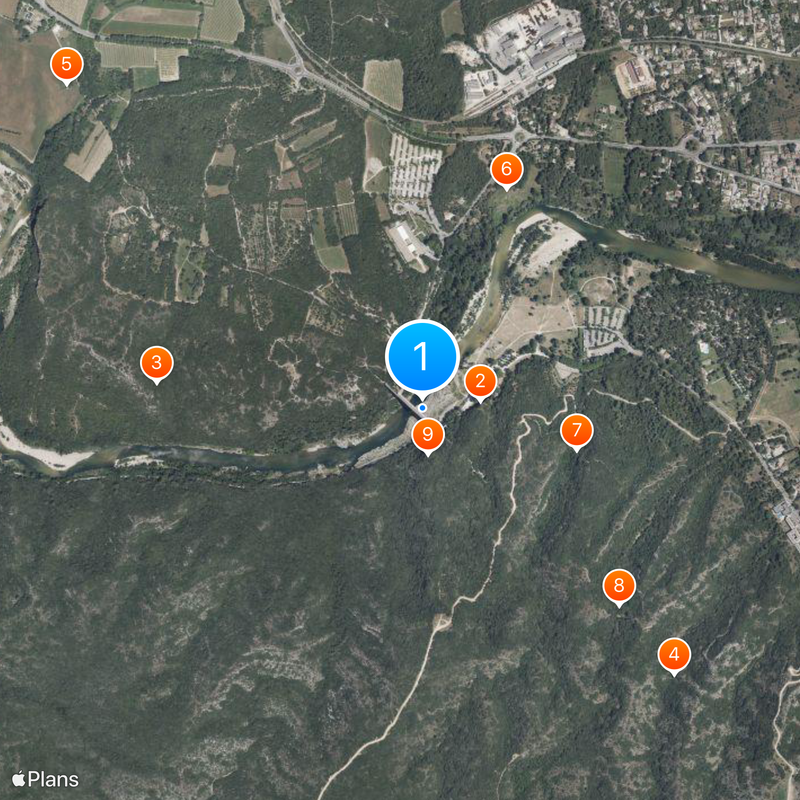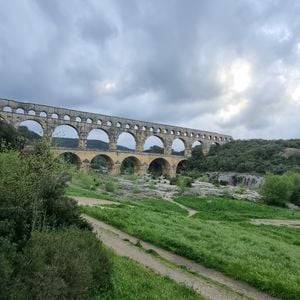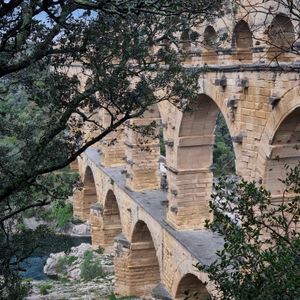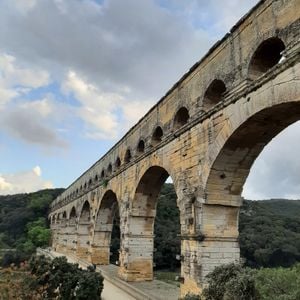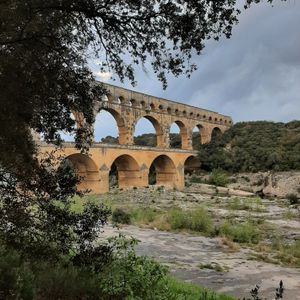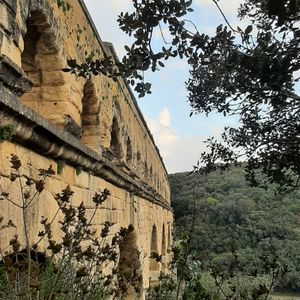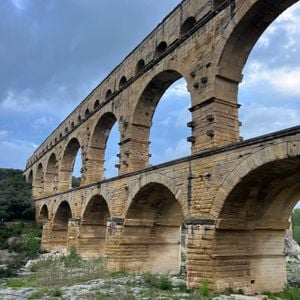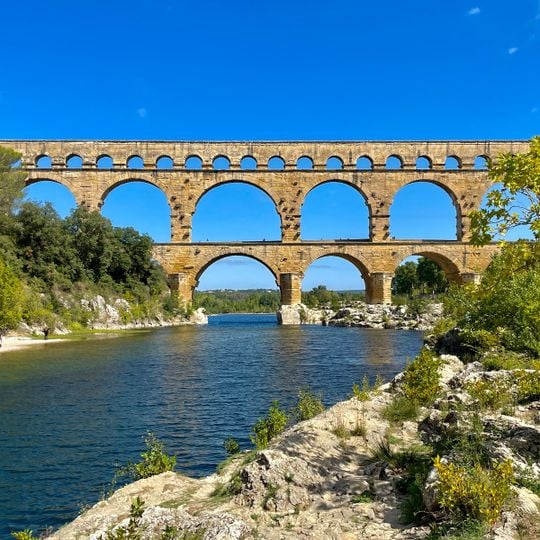
Pont du Gard, Roman aqueduct bridge in Vers-Pont-du-Gard, France
The Pont du Gard is a Roman aqueduct bridge built from shelly limestone that crosses the Gardon River near Vers-Pont-du-Gard on three levels and is listed as a World Heritage Site. The structure extends 275 meters in length and rises 48 meters above the riverbed, with the upper channel originally used for water transport.
The structure was built between 40 and 60 AD to supply drinking water to the colony of Nîmes from springs near Uzès. The bridge formed part of a 31 miles (50 kilometers) aqueduct that carried large volumes of water into the city daily.
The name derives from the Latin "pons" for bridge and the Gardon River, whose old designation was Gard. Visitors today come to picnic on the banks, swim in the shallow water, and view the arches from below.
The grounds are open throughout the year and offer wheelchair-accessible paths to the main viewpoints. During the height of summer, the site stays open until midnight, allowing visitors to experience the arches at sunset or after dark.
The stone blocks were assembled without mortar and weigh up to six tons each. This technique allowed the construction to endure two millennia, with the joints still fitting together precisely today.
Location: Vers-Pont-du-Gard
Inception: 1 century
Height: 48 m
Length: 275 m
Accessibility: Accessible en fauteuil roulant
Made from material: shelly limestone
Part of: Nîmes aqueduct
Address: Route du Pont du Gard
Opening Hours: Lundi-Dimanche 08:00-00:00
Phone: +33466375099
Website: https://pontdugard.fr
GPS coordinates: 43.94730,4.53550
Latest update: December 14, 2025 19:31

France's historical architecture documents two millennia of construction, from Roman amphitheaters to modern bridge engineering. The structures demonstrate developments in engineering and architecture across multiple periods. The heritage extends from medieval fortifications like Carcassonne and the...

Bridges are a part of our daily lives. They have connected banks, valleys, and communities for centuries. This collection presents structures from various periods and regions. From medieval stone arches to modern steel constructions, these works demonstrate the evolution of engineering. The Rialto...

France offers diverse winter destinations spanning both urban and natural landscapes. The Alpine regions contain several ski areas, including Chamonix-Mont-Blanc at the base of Western Europe's highest peak, Les Trois Vallées with its extensive network of runs, and L'Alpe d'Huez at elevations above...

Stone arch bridges rank among the most durable structures in history. From Roman aqueducts in Spain to medieval river crossings in Central Europe, these constructions demonstrate the evolution of engineering over two millennia. The Pont du Gard in France once transported 20,000 cubic meters of water...
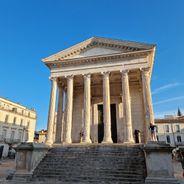
Nîmes brings together two thousand years of architecture in one view. As you walk, you pass from the Roman amphitheater of the first century to the glass façade of the Carré d'Art, built in the 1990s. The Maison Carrée, an ancient temple with Corinthian columns, faces this contemporary art museum in...
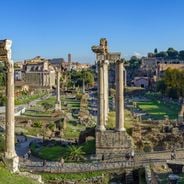
Europe brings together signs of the past that tell thousands of years of human history. From Greek temples on the Acropolis in Athens to Roman arenas at the Colosseum, from the stone structures of Stonehenge to Renaissance palaces, each era has left buildings that still speak today. These sites help...

Grotte de la Salpêtrière
178 mGrotte de la Balauzière
813 m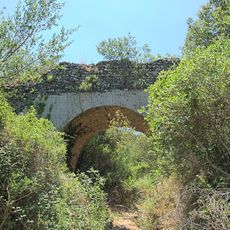
Pont de la Combe Joseph
1.1 km
Chapelle Saint-Pierre de Vers-Pont-du-Gard
1.5 kmCarrière de l'Estel Sud
715 m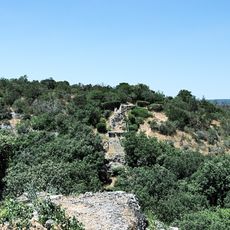
Pont du Combe Roussiere
488 mAqueduc de Remoulins
850 mScenic viewpoint
141 mScenic viewpoint
104 mScenic viewpoint
268 mScenic viewpoint
217 mScenic viewpoint
208 mScenic viewpoint
153 mBelvédère Mémoires de Garrigue
836 mPoint de Vue
431 mScenic viewpoint
131 mScenic viewpoint
152 mScenic viewpoint
125 mScenic viewpoint
372 mMémoires de Garrigue
575 mOliviers Millénaires
153 mLa Charbonniere
796 mSite du Pont du Gard
376 mTunnel
199 mRuins
133 mArchaeological site
777 mCommemorative plaque, memorial
47 mRuins
1.3 kmReal people, real opinions — but not verified.
Visited this place? Tap the stars to rate it and share your experience / photos with the community! Try now! You can cancel it anytime.
Remarkable site and great museum, including for children.
Discover hidden gems everywhere you go!
From secret cafés to breathtaking viewpoints, skip the crowded tourist spots and find places that match your style. Our app makes it easy with voice search, smart filtering, route optimization, and insider tips from travelers worldwide. Download now for the complete mobile experience.

A unique approach to discovering new places❞
— Le Figaro
All the places worth exploring❞
— France Info
A tailor-made excursion in just a few clicks❞
— 20 Minutes

